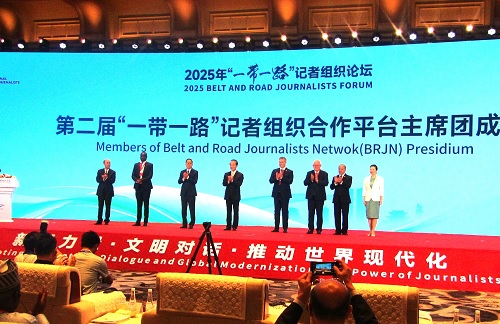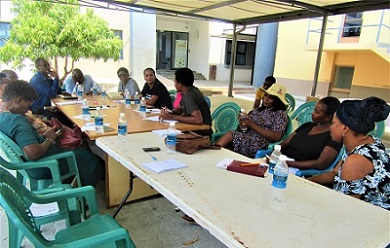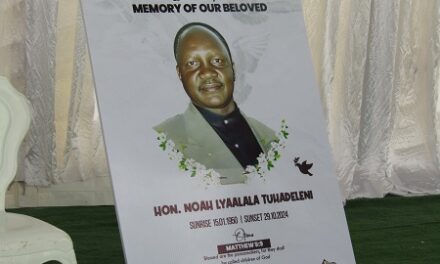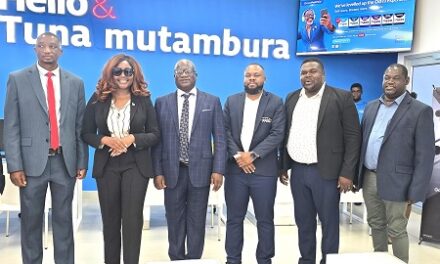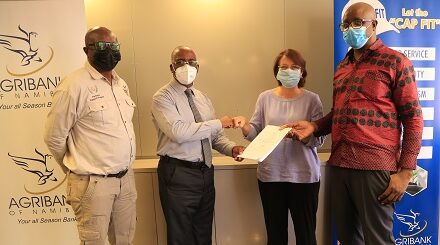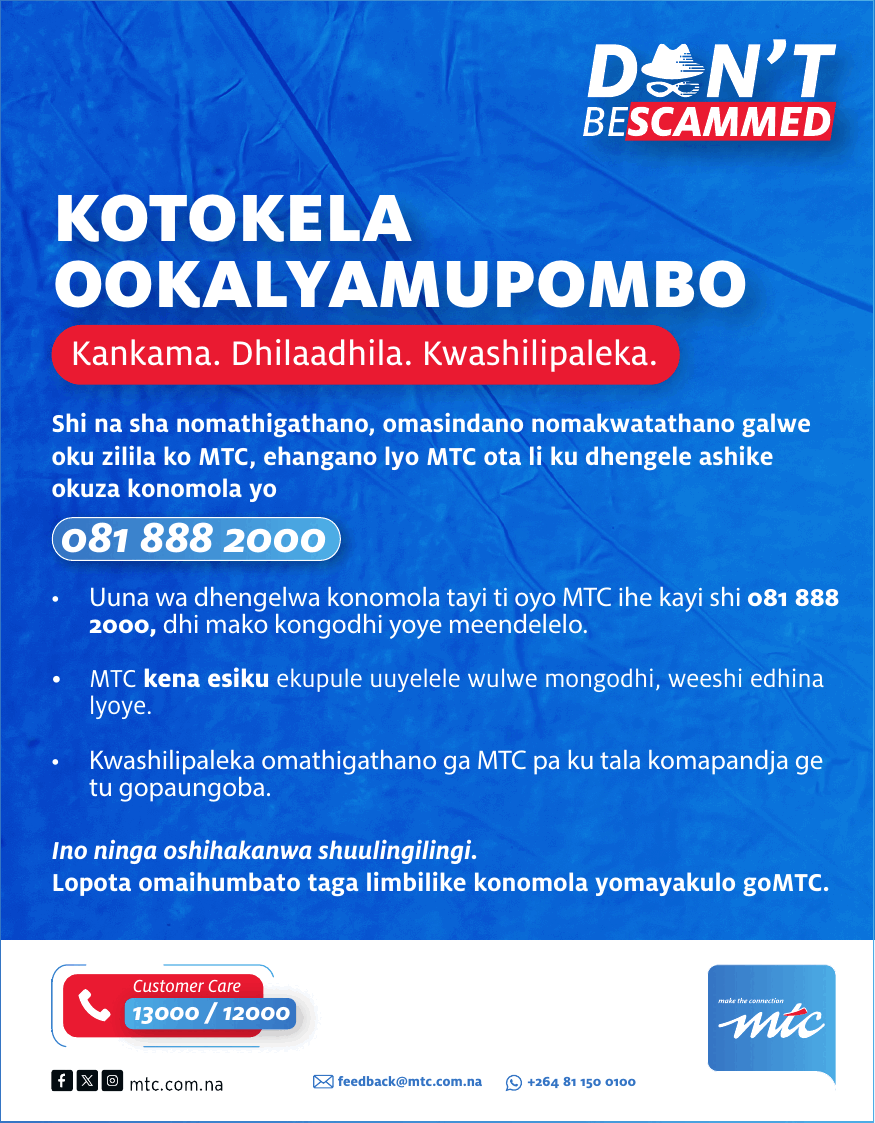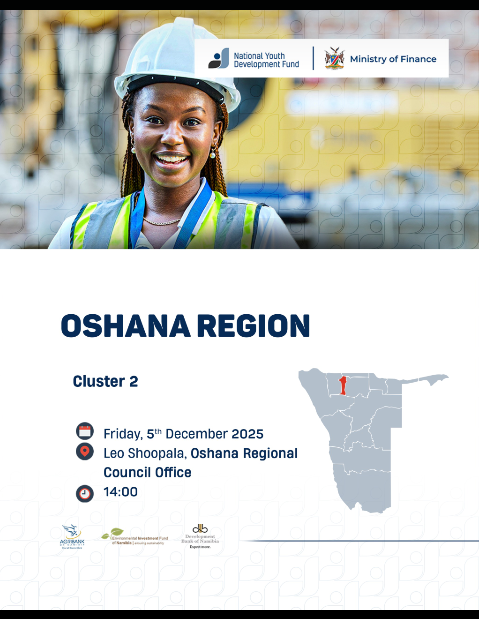By Victor Angula /
AFTER a 13 hours flight we finally touched down. The first five hours were on an Ethiopian Airlines from Windhoek to Addis Ababa. And then this was eight hours of flying from Addis Ababa on another Ethiopian Airlines plane. Instinctively we clasped onto our passports in anticipation of the tough security procedures at the Chinese border.
“… ladies and gentlemen, we have touched down at Chengdu-Tianfu International Airport, in China; kindly do provide your yellow fever vaccination card upon request. I wish you the best,” the flight attendant announcement sounded as we unstrapped our seat belts.
“My God,” Tuyeimo hissed. “Victor, did you bring along your yellow fever card?”
“No.”
Suddenly we started to panic. We stood in the plane’s aisle with the rest of the passengers who numbered nothing less than 150 on this economy class flight. As we stood for about five minutes waiting for the business class passengers to disembark first we engaged in a hushed but worried conversation. It was the first time I was hearing about the need for this yellow fever card. “Were you told about it?”
“Yes, Jemima said so. I just left mine at home. Now I don’t know if it will be possible to phone back and ask them to take a picture of it.”
Tuyeimo Haidula was my travelling companion. She was going to represent the Namibian Media Professionals Union (NAMPU) at the 2025 Belt and Road Journalists Forum, and I had to tag along as an accompanying journalist.
“But they should have said so as another requirement when we applied for the visa,” I said.
Tuyeimo’s mind was spinning round, considering all the possible scenarios ahead of us. Then it was time to disembark. “Let’s get going and see what will happen. Hopefully they will not send us back home.”
As always, Tuyeimo walked ahead in front of me. She stepped through the first security check point. It was my turn. As I stepped out a security officer stopped me and pointed to a nearby door, “Go there, go in.”
Tuyeimo was going on ahead, and I couldn’t shout out at her. I couldn’t send her a text message either as I had long ago left my MTC connection in the skies of Namibia. I sat on my nerves on a chair in the “health check” room at Chengdu-Tianfu Airport, thinking of what to say if and when asked to produce a yellow fever card; then I was given a thermometer to put under my armpit. We were four of us in the room; the others were Chinese nationals.
After some five minutes the thermometer was taken and I moved to the table where an official explained to me that I showed signs of fever, and I had to give my contact details and have my blood drawn if I wanted.
“Okay, no problem,” I said. The official asked me the purpose of my visit, and I gave her all documents I had: passport, flight tickets, invitation letter, and accommodation information.
In another 10 minutes I was shown to another room, where a health official drew my blood, and I came back to the first official. Then she asked me to sign on a piece of paper printed in Chinese language.
“Take this, if you become sick in the next two weeks, just go with it to the hospital.”
As I stepped out I had two security officers help me out in filling the arrival forms. I then moved to the counter where they checked my passport and I had to stand in front of a camera. Next to me was a lady who asked me where I was from and if I was traveling for the Belt and Road meeting. I said, yes. She was also here for it, all the way from South America. I was kind of relieved having another companion as I couldn’t see Tuyeimo.
Then I was told to move through. And there Tuyeimo stood waiting for me with a quizzical look on her face. “Where were you?”
We were relieved. Now we had to take a domestic flight from Chengdu-Tianfu Airport to Ganzhou City. We had to run through the whole airport building to the connecting terminal as we were getting late for our next flight. Luckily the flight was delayed for some minutes so that we just got there in time.
It was another hour and half of flying, before we arrived at our destination. We went through the security checks, and we collected our luggage. Then as we stepped out, wondering where to go at this overcrowded airport, several young people were there wearing t-shirts and caps and holding signs written “Belt and Road, welcome”.
They already knew us by our names after we said we were from Namibia. We were ushered to the bus. We were now in Ganzhou City, in Jiangxi Province, China, which became a hive of activities from 14 July to 19 July 2025 as more than a hundred media practitioners from across the world gathered for round-table discussions on “Promoting Civilisations Dialogue and Global Modernisation with Power of Journalism”.
The initiative is the brainchild of the Belt and Road Journalists Network (BRJN), which is an international exchange and cooperation platform jointly initiated by the All-China Journalists Association and journalists’ organisations from Belt and Road partner countries and regions.
The Belt and Road Journalists Forum is a major event of the Network, which has been held since 2017, highlighting the need and importance of strengthening news exchanges, enhancing mutual understanding and trust between nations, and fostering people-to-people cultural exchanges – through the power of journalism.
This year a total of 100 guests from 50 countries represented media organisations at three roundtable discussions. Scores of local journalists, representatives of Chinese media and media training institutions, and local politicians too, also were part of the event.
On arrival we were registered, and 1000 Yuan (which is equivalent to N$2,400) was given to me for my article on my “First Impressions of Chinese Culture” which I had submitted with the application to attend the 2025 Belt and Road Journalists Forum. The article, titled “The Enigma of Chinese Culture” was featured in the Forum’s official publication FIRST IMPRESSIONS OF CHINESE CULTURE, together with 157 articles by other international journalists.
We then got back to the bus for a night sightseeing through the city before we got to the hotel where we were booked for the night and dinner.
We woke up in Nanchang City, and in the morning of 15 July we were in a group of 27 individuals on a bus, accompanied by our local volunteer assistants for our convenience, although we also had Mr Ken Chen who served as our official interpreter. We also had Professor Zheng Changzhong with us. This group, which was known as “Group 1,” consisted of colleagues from English-speaking African countries, including media colleagues from a few other eastern countries such as Sri Lanka, Maldives, Indonesia, Malaysia, and India.
Spanish speaking countries were in another group, known as “Group 2,” totaling 26 individuals, including Egypt and Oman who were the only Arab-speaking nations. Group 3 consisted mostly of the “stan” nations: Kazakhstan, Kyrgystan, Pakistan, Uzbekistan, with Vietnam, Laos, Bangladesh, and eastern European countries such as Russia, Belarus, and Armenia joining them.
European countries made up “Group 4,” together with UK and the USA. Ukraine, however, was notably absent and did not feature on the guest list. Israel too and Iran, and Irag, did not feature. On the African continent, it was Zimbabwe who was notably not there – although a lot of other countries such as Uganda, Cameroon, Ghana, Senegal, Mali, Burkina Faso, Libya, South Sudan, DRC, Togo, even Botswana and Angola, etc., did not make it to the invited guest list.
This first day, the 15th of July, after breakfast, we were taken to the Jiangxi Provincial Museum. The museum, initially planned in 1953 but officially opened to the public on 1 July 1961, is a four-storey building that houses a lot of historical items of Chinese heritage dating back to centuries ago. Household utensils, pottery products, jewelry, gold ingots from tombs of noblemen, specimens of ship building in the early days, traditional architecture, patterns of dragons, and lots of other things of historical significance. Ms Dong Li was there to take us through, explaining everything – what it is, its significance, and so on – while Mr Ken Chen interpreted.
Next, in the afternoon, we went traveling by speed train to the province’s capital city, Ganzhou City. From Nanchang Train Station, we disembarked at Longnan Train Station. While this was just a train station, the infrastructure looked much like an airport. We climbed onto tourist carts for sightseeing and a visit to the Yangming Mind Valley Scenic Area some 3 km downtown to the east, where we climbed up the steps into a cave after we were received with a dance by children from Yangming Primary School. Here, in a huge and wide cave hollowed in a mountain, is where Mr Wang Yangming used to do his academic researches, meditate and teach his disciples.
We sat down all of us on the floor of the cave with crossed legs, the way the disciples of Mr Yangming used to sit, and we were given a lecture by Mr Liu Hefu on the history of the cave and the work that was done here some 500 years ago. Amongst many other things, Mr Yangming taught that it’s easy to defeat the bandits in the bush than to defeat the bandits in one’s own mind.
We then went out of the cave through a northern exit, got on the tourist carts and went to the Yangming Memorial Centre, where a lot of things about Mr Yangming and his teachings were on display and were explained to us. We also sat down to do Chinese character (word text) printing. And from there we went to the Old House Hotel, also known as Laounxi.
On 16 July, already by 9 AM we were taken by bus to the Guanxiwei Scenic Area. The thing about this Jiangxi Province was that the whole place was just a scenic area. It was a mountainous region, and as we went through city to city town to town and village to village, everywhere was green, and clean. And you cannot but observe that there was so much responsible driving in this country, no speeding and reckless overtaking. One just felt safe on the roads.
And all the way on the bus ride Professor Zheng Changzhong of Fudan University was giving us a lecture, on China’s history and culture, on Taoism, Buddhism and Confucianism as they had impacted and influenced Chinese civilisation and its transition to modern development. He also shared knowledge of how China lifted millions out of poverty in the last few decades, describing it as a deliberate and concerted effort to create “moderate prosperity for all”.
Next we made a stop at the World Hakka Folk Culture City in Longnan County. The Hakka ethnic Chinese have preserved customs of the Central Plains in the Tang and Song Dynasties, cultural practices such as the Taipingbao Dragon Boat Race, Hakka Folk Songs, Hakka Ribbons, Hakka Dragon Dance, and the Celebration of Ceremony for Having Babies.
We were received at one enclosed castle which served as a fortified house built in the Jin dynasty in 18th century. We were treated to a Hakka opera performance and Hakka traditional food after we had toured the mansion. Then we went to the Hakka Cultural Centre where we were welcomed by a lion dance of Hakka tradition, before we toured the building, where we found people demonstrating their inherited skills in Sibao engraved block printing, Xuan paper making, Hakka folk music, Hakka puppet and Hakka drama. Then we rounded off with a turn at the Hakka Shop – where traditional products by Hakka people were sold.
In the afternoon we went to visit the Low-Altitude Economy Industrial Park, a 5 billion Yuan industry that designs and manufactures drones for sport and agricultural purposes. In 2024 they had produced 15 000 drones, for export mainly to Europe and US. Then we dashed off to the Ganzhou International Land Port, which is Jiangxi Province’s logistic hub for international trade, where mostly timber is received from all over the world, and where it is shipped back in the form of finished furniture products.
Just next by was the Meike Shuchuang Home Intelligent Manufacturing Co. Ltd. At Meike we were shown around the showroom, where we saw, touched and sat on locally made furniture such as tables, chairs, and beds, lounge sets and cabinets of high quality made of wood, metal, glass material and ceramic.
At three in the afternoon we went for the “Dialogue with the Mayor” activity in Home Furnishing Town, Nankang County, at City Parlour Hotel. The activity was moderated by Professor Zheng Changzhong. Mr Li Kejian, Mayor of Ganzhou Municipal Government, gave a speech, stating that Ganzhou is a revolutionary area, known as the ‘red city,’ and an historical city; it is also well known as an environmentally friendly city. The city is promoting cross-border trade and looking for international economic cooperation.
“We offer foreign investment opportunities,” he said. “We are unlocking doors of a new era of shared development.” He also stated that his city and his province and country have been prioritising the need to lift people out of poverty.
“Every year we provide funds to alleviate the poverty of our people. As a result our people enjoy happiness and shared prosperity.”
A question-and-answer session also took place with the mayor.
On 17 July as we finished with breakfast and prepared to go out for the day’s activities I couldn’t see my companion. Upon inquiry I was told that Tuyeimo was in her hotel room resting as she had been taken in the night to the hospital. It came to my mind that the fever which was “detected” on me on arrival at the airport was actually symptoms detected on my companion when she went through the airport security scan ahead of me.
The day started off with a visit to Yilian Technology Co. Ltd., where Billionsports Technology Co. Ltd. was in business producing safety helmets for cycling, skiing and for law enforcement. They also made pickleball racquets and balls. Their biggest market was the US, but the local pickleball sport was also growing rapidly. Then we went to the sport centre of Shangyou. Here we learned of the sport known as pickleball, which was much like tennis. It was fun playing it.
In the afternoon we went to Yuan Village of Meishui, a tea-making village of 3,600 residents. The village was one of the best producers of Chinese green tea, with 11 tea plantations. We were about to take a 13 kilometre train ride through the village, but the train refused to start. We learned that the village’s train station was built in 1960. We then got on the tourist carts and went to one tea plantation where we picked tea leaves and went in the tea drying factory where we learned how tea leaves were dried.
I asked for permission to take the tea I had dried, and was granted the request. As we were about to go the young lady, who had assisted me in drying the tea, came back and handed me a “gift” of a small bag of tea. I was excited. And we went out to take a ride on the tourist carts.
Before we started off I went to the toilet, only to come back and find my tea which was given as a gift was gone. Somebody took it from the seat of the tourist cart where I had left it. I protested and asked who took it. I was told that I was given the “gift” by mistake. Apparently the tea was bought by someone else and then given to me by mistake.
Dejected, off we went. From there we went to Chanshanju Lodge, where we saw how the beauty of nature was modified by a touch of modernity to create a tourist attraction sight. Beautiful cottages were perched on the side of mountains with a connecting bridge between. I thought of how we could do the same back home.
In the evening we went to visit the Jiangnan Song City. So far we hardly saw anybody in the streets of any of the Chinese cities and towns we visited except at the places where we had gone. During the day Chinese cities were empty, as everyone was hidden someone busy doing whatever they did for a living. Only in the morning and afternoon’s rush hours would you see people going to work or going home after a day’s hardwork. And people mostly used scooters. No minibuses or taxis.
Now here we were at the Jiangnan Songcheng historical and cultural tourist zone, where we mingled with Chinese people. They welcomed us, some danced for us and we joined in on the fun, and some offered us Chinese food and sweets made out of honey. Being Africans as most of us were, we just took anything offered to us. We also went to the Song Dynasty Tower, built in 1023 AD, where crowds of people had gathered to witness our welcoming by descendants of the dynasty.
On 18 July, in the morning, we went for a visit to the Fushougou Museum. Fushougou has a history of being a city with an elaborate drainage system dating back to centuries ago. We were shown around the museum and told how Chinese city construction knowledge evolved over centuries, from building walls with sand to using stones and then bricks.
Then mid-morning we went for shopping. The bus dropped us at the Mix complex. One thing about this society was that immediately you could observe that theft crime was not one of the issues with them. Shops were so open that anybody could go in and out without anybody caring to look if somebody wanted to shoplift.
In the afternoon everyone was back, for the day’s roundtable meetings.
The China-Latin America Journalists Roundtable took place under the theme: ‘“The Rise of the Global South’ and New Opportunities for China-Latin America Cooperation – The Mission of the Media in Our Era”.
While the China-EU Journalists Roundtable was held under the theme: “How to Achieve a Shared Future amid Profound Changes – the Responsibility and Role of Chinese and European Media”.
The rest of the guests were gathered for two separate seminars, one under the theme: “Innovating Cross-Cultural Narratives and Fulfilling Media Responsibilities under the Global Civilisation Initiative,” while the other seminar was held under the theme: “Upholding News Authenticity in the Age of Artificial Intelligence”.
The main day of the occasion was the 19th of July 2025, attended by eminent personalities such as Ms Lu Xiaoqing who is a member of the Standing Committee of the Communist Party of China (CPC) Jiangxi Provisional Committee and a director of the Publicity Department of the CPC Jiangxi Provisional Committee, and Mr Huang Xizhong who is a member of the Standing Committee of the CPC Jiangxi Provisional Committee and the secretary of the CPC Ganzhou Municipal Committee.
The day’s event consisted of welcoming remarks by Ms Lu Xiaoqing, and a speech by Mr Huang Xizhong. Mr He Ping, a member of the Presidium of Belt and Road Journalists Network and President of All-China Journalists Association, delivered the keynote speech, in which he stated that the world must start now to appreciate one another and thrive together by engaging in mutual learning and build bridges for common success.
“China’s path to modernization is peaceful,” he said. “China is steadfast to the ideal of promoting peace and defending international order.”
Another keynote speech was delivered by Mr Andrei Kryvasheyeu, the Rotating President of the Presidium of Belt and Road Journalists Network and also President of the Balarusian Union of Journalists. Kryvasheyeu stressed the need for a stronger unity of journalists for more “protective methods,” saying “when journalists are under pressure or facing legal sanctions, we should raise our voice.”
Other presentations included the presentation on the new International Home of Journalists programme, the awarding of the “My Marathon” global micro-video competition winners, the “Fresh Insights of Civilisations Dialogue” speech, Belt and Road Journalists Station presentation, and the “Media Ambassadors” speeches, as well as the handing over of recognition certificates to journalist organisations from 11 countries, before the 2025 Belt and Road Journalists Forum was closed off in the evening with a banquet.
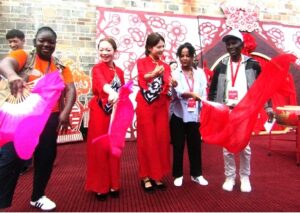
In the photo: Members of the Belt and Road Journalists Network Presidium; in another photo, from left, Edith Mwiinga of Media Science Café in Zambia, Selam Eshete of Fana Media Corporate in Ethiopia, and Victor Angula of Omutumwa News Online in Namibia learning the moves from Hakka traditional dancers.

